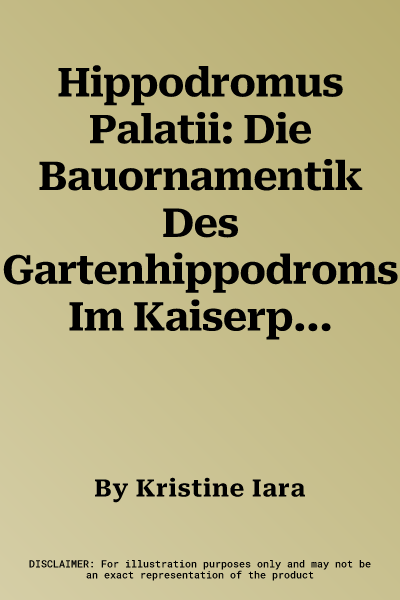Kristine Iara
(Author)Hippodromus Palatii: Die Bauornamentik Des Gartenhippodroms Im Kaiserpalast Auf Dem Palatin in ROMPaperback, 18 August 2015


Description
English summary: For centuries, the Imperial Palace on the Palatine Hill in Rome served as the seat of the Roman emperors. Significant portions of the palace have survived, but mostly in the form of opus caementicium walls, devoid of the original architectural decoration. Despite its enormous significance to architectural history and its socio-political importance, the palace has only become an object of systematic scientific study within the past 20 years. This monograph focuses on an important feature of the palace: the Hippodrome garden and its architectural decoration. The monograph sheds light on central aspects of Roman architectural history in two respects: By presenting the architectural decoration of the Hippodrome garden as a body and by subjecting it to comprehensive analysis for the first time, this work contributes to the study of architectural decoration in the city of Rome. At the same time, the work closes a gap in the study of the Imperial Palace. The Hippodrome, built chiefly during the Flavian and Severan eras, is one of the largest garden facilities in the palace. Part of it has survived in the form of masonry walls; part in the form of approximately 900 fragmented marble components. In the first section of this work, these components and their ornamentation are catalogued and analyzed for the first time. The architectural decoration of the Hippodrome is reconstructed on this foundation. The second section is dedicated to an overall assessment of the decoration, and of the structure itself. Typologically, the structure belongs among the hippodromi, a distinct kind of Roman garden found in villa architecture. By analyzing its architectural decoration and assessing its place within the palace facility as a whole - as well as within the broader context of garden and villa architecture during the imperial period - we reach a new understanding of the structure and how it was integrated into Rome's Imperial Palace. The Hippodrome garden on the Palatine is an exceptional example of this building type, representing an elevated, refined version of a form adapted from the architecture of aristocratic villas. Integrating a known form into the Imperial Palace - a form already established in villa architecture - was intended to make the greatest possible impact while also finding acceptance among the populace. The general popular recognition of the building type at once warded off the impression of extravagance, while simultaneously implying the magnificence of such a facility through its association with the word hippodromus, alluding thereby to the magnificence of its contractor, the emperor. Thus, considering its design, its decoration features, and the connotations tied to these, the construction of a hippodrome garden in the Imperial Palace in Rome signified imperial standing of the highest order. German description: Der Kaiserpalast auf dem Palatin in Rom hatte als Sitz der romischen Kaiser uber Jahrhunderte Bestand. Bedeutende Teile sind von ihm erhalten, allerdings hauptsachlich als Mauern in Opus caementicium ohne die ursprungliche architektonische Ausstattung. Trotz seiner immensen architekturhistorischen und soziopolitischen Bedeutung ist der Palast erst seit den letzten 20 Jahren Gegenstand von systematischen wissenschaftlichen Untersuchungen. Diese Monographie hat einen bedeutenden Teil des Palastes zum Thema - den Gartenhippodrom und seine Architekturdekoration. In zweierlei Hinsicht erhellt sie zentrale Punkte der romischen Architekturgeschichte: Durch die geschlossene Vorlage und die umfassende Analyse der Architekturdekoration des Gartenhippodroms tragt sie zur Erforschung des stadtromischen Ornaments bei. Zugleich schliesst sie eine Lucke in der Erforschung des Kaiserpalastes. Der Hippodrom mit einer flavischen und einer severischen Hauptbauphase ist eine der grossten Gartenanlagen des Palastes. Er ist zum Teil in aufgehendem Mauerwerk, zum Teil in rund 900 fragmentierten Marmorbauteilen erhalten. Im ersten Teil der Arbeit werden diese Bauteile und ihre Ornamentik erstmals vorgelegt und analysiert. Auf dieser Grundlage wird die Rekonstruktion der Architekturdekoration des Hippodroms unternommen. Der zweite Teil der Arbeit ist der Gesamtbewertung der Baudekoration und des Bauwerks gewidmet. Typologisch gehort es zu den hippodromi, einer bestimmten Auspragung romischer Garten aus der Villenarchitektur. Die Analyse seiner Architekturdekoration und seine Bewertung innerhalb der Palastanlage insgesamt sowie im Kontext der Garten- und Villenarchitektur der Kaiserzeit fuhren zu einem neuen Verstandnis des Bauwerks und seiner Integration in den stadtromischen Kaiserpalast. Der Gartenhippodrom auf dem Palatin ist ein herausragendes Exemplar dieses Bautypus. Er zeigt die aus der aristokratischen Villenarchitektur ubernommene Bauform in einer gesteigerten, raffinierten Version. Die Integration einer bekannten, in der Villenarchitektur bereits etablierten Bauform in den Palast des Kaisers hatte grosstmogliche Wirkung bei gleichzeitiger Akzeptanz in der Bevolkerung zum Ziel: Durch die Bekanntheit des Bautypus wurde der Eindruck von Extravaganz vermieden, zugleich aber war bereits mit dem Namen hippodromus die Grossartigkeit einer solchen Anlage gewiss und verwies auf den Bauherrn, den Kaiser. Aufgrund der Bauform, der Ausstattung und der damit verbundenen Konnotationen bedeutet die Errichtung eines Hippodromgartens im stadtromischen Palast kaiserliche Reprasentation auf hochster Ebene.